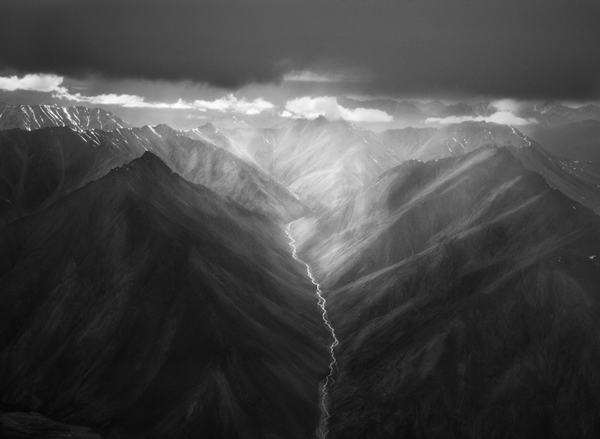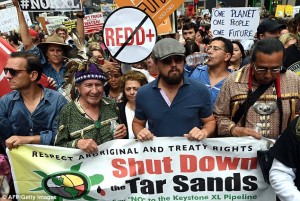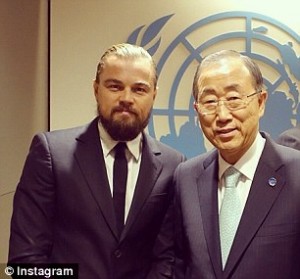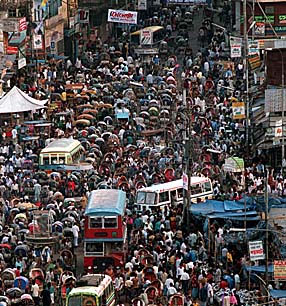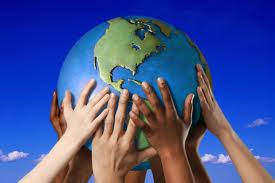Earlier this week, famed nature photographer and documentarian James Balog was on Dickinson’s campus for a two-day residency as part of the Rose-Walters Prize he received at Commencement this past May. His vivid pictures and time-lapse videos of glacial retreat are a stark representation of the scope and rate of global warming and climate change in our own lifetime. While Balog approached his photography as an avenue for showing the beautiful destruction of the climate, Brazilian photographer Sebastião Salgado’s most recent work, Genesis, shows the inherent beauty of the world that is at peril of being disturbed or lost forever to the effects of climate change. Deserts, ice, endangered species, beautiful designs naturally cut along a valley are a few of the subjects of Salgado’s photographs. His work approaches the same vein as Balog’s, just from a different angle, and both angles have a story that is important for everyone to experience and internalize as we approach the climate question. The Earth around us is a beautiful, one-of-a-kind environment that is imperative for us to cherish and protect from ourselves so that future generations may have the privilege and honor to cherish and protect it as well. As we move forward in our work this semester at COP20 and in all future climate negotiations, it is crucial that this message not be lost upon us.
Green Devil Interview!
The Green Devil of Dickinson College was interviewed about climate change today! Check out what he had to say!
Actors pretend for a living, the rest of the population does not.
Tuesday morning actor Leonardo DiCaprio addressed world leaders at the UN Climate Summit. What was this product of hollywood doing in a room full of heads of states? Well, he compared his acting career of “pretending for a living” and “solving fictitious problems” to how humankind is confronting climate change, pretending it is not happening to our planet. I’m sure many of us has seen hollywood “climate-fiction” films such as The Day After Tomorrow, but we must be able to differentiate fact from hollywood’s fiction. Is getting the fictitious world of hollywood involved in the fight against climate change an effective wake up call? How do we get the people to stop pretending and face reality?
Read DiCaprio’s full speech here
Exploitation At It’s Finest

Exploitation At It’s Finest
One idea in the passage that does not allow for interpretation is that humankind is exploiting the world for its resources that help us survive, but this exploitation of earth for our needs is coming to an end with global climate change negotiations and adaptations on the rise. Another widely understood component is that climate change has already struck and is striking currently. In addition, the Parties should be preparing for what has yet to come by reducing the triggers of climate change and by cleaning up the damaging effects that it has already caused.
While there are grave and irreparable damages that climate change has and could cause, it is not the reason to stop trying to bring it to a halt. Even the uncertainty of scientific evidence is not a good enough reason. Earth as we know it will soon disappear because of our doings. We are the reason for it being in this state. One just wonders just how the should go about reducing or stopping the effects of climate change. We want to reduce or stop it where we will benefit the most but at the lowest possible cost. Just how will we do it though?
Global benefits are spoken about in the article. However, there is a question of who will ultimately benefit. Will it be the developed or developing nations? Developed nations carry more CO2 emission weight but developing nations carry some too. Developed nations are more powerful though, which may play a role on who benefits more ultimately. Also, there are implications in figuring out a solution to this problem in a cost effective way. Who will figure that out and how will they figure that out? It is still very vague and up in the air. Cost effectiveness is a factor that drives the solution but it’s not the solution as a whole.

Climate Change’s Super Hero Power is the Ability of Interpretation

Everyone can interpret a sentence differently whether it’s in a poem, textbook, short story or even a UNFCCC article. Although the UNFCCC report’s tone was concise and scientific, I was still able to create three different interpretations from the same two sentences. The sentences contained both understandable ideas and contested elements, which could result in Parties having conflicting opinions about the same passage.
The overall message from the passage is that the needs of the climate system should be addressed if we want it to survive for the future generations to come. If we use up earth’s resources and suck out all of its natural beauty, what will be left to benefit our future generations? Another clear idea is that countries that have contributed the most to climate change should be held the most responsible for finding a solution to climate change’s issues.
There are specific words and phrases that are vague and within the context could be interpreted very differently. One contestable phrase is “respective capabilities” for each country could argue it is not capable of handling the major issue of climate change in addition to the country’s own domestic and international issues. Another main implication from this passage is that is calls for “developed countries to take the lead in combating climate change”, but it should be a collective effort when fighting climate change and its effects. If the developed countries take the lead, they have the ability to manipulate the ways in which climate change will be combated and by whom. Developed nations have contributed the most to climate change and should be the main compensators, but the role of developing countries should not be underestimated. This phrase affirmed the tone for climate change negotiations and simultaneously gave developed nations control.
In addition, referring to countries as “developing” seems disrespectful and creates a hierarchy, causing commonalities and differences between developed, and developing countries. Another word that I found to be problematic was “protect” because the context allows for free interpretation. It is not specified what the parties need to “protect” climate systems from, however, it most likely pertains to the effects of increased greenhouse gas emissions Furthermore, the language barrier could result in varying interpretations because there are English words that don’t exist in another language or that do not translate with the intended meaning. Overall, it is evident that interpretation is something to be cautious of when dealing with climate change
.
The World May Not Be Flat, But It’s Sure Growing.
Last Thursday, a group of international researchers released a report that projects a global population increase from seven billion today to eleven billion by the end of the century. This overturns a general agreement worldwide that population would only peak at about nine billion people in 2050, which was the assumption underlying a plethora of key scientific reports on malnutrition, HIV/AIDS, demographic composition of different countries, and, most interestingly for our purposes, all previous Intergovernmental Panel on Climate Change (IPCC) reports on the threats of climate change and global warming.
This burgeoning population could reach, as Simon Ross from the think tank Population Matters told the Guardian, “between 40-75% larger than today in the lifetime of many of today’s children and will still be growing.” The implications of this on resource use and energy demand will be quite significant: more people will require more resources in order to survive, but the resources are in finite supply, so competition will increase, thus putting pressure on those at the margins who may be denied access. With this grim prospect, we can expect to see more exaggerated poverty and strife worldwide, while aggregate resource use can be expected to increase.
This will pose a large roadblock for any future agreements to reduce greenhouse gas emissions because not only is the necessity for emissions reductions compounding over time, but so is the difficulty of achieving that aim (mainly due to the reasons I discussed above). The momentum must be continued now and aggressive reductions must be made now so that, moving forward, the work before us will be within our reach to achieve; if we wait any longer, that work will only get harder and harder, and further and further out of our ability to cope.
Carrington, Damian. 2014. “World population to hit 11bn in 2100 – with 70% chance of continuous rise.” The Guardian, September 18.
Climate Change and Indigenous Communities in the Arctic
The Arctic, defined as the area north of 66 degrees 33 minutes North latitude, a.k.a. the Arctic Circle, is home to a multitude of indigenous people, among them the Inuit in Greenland, Canada and Alaska, the Inuvialuit in western Canada, the Athabaskan in Alaska and Canada, and the Saami in Norway, Sweden, Finland and northwest Russia. These people’s cultures and traditional lifestyles are shaped by the Arctic environment, and because of this these people are very vulnerable to climate change. For people who depend on a stable local environment to support and sustain their settlements and lifestyle, a changing climate can have a very injurious effect. One of the ways in which the warming climate can adversely affect indigenous people is that the weather becomes less stable and therefore harder to predict. Experienced hunters and elders have reported that traditional techniques of predicting the weather are becoming ineffective, with storms occurring without warning and wind direction changing suddenly. This unpredictability in the weather can present problems when trying to figure out the best times to, say, dry fish, or lead a hunting party. Yet another problem is that the changing climate has brought about more freezing rain. This affects snow characteristics, and nowadays, Arctic natives report that there is a lack of good snow that can be used to build igloos. This is causing an increase in injuries and deaths for members of hunting parties because the hunters are unable to build shelters quickly enough when faced with a sudden storm. Another problem caused by freezing rain is that much of the wildlife of the Arctic, including reindeer and musk ox, cannot find food in the winter due to the thick layer of ice covering these animals’ usual food sources. This will in turn affect the indigenous people who depend on these animals for food. Climate change has also caused sea ice to decline in both extent and thickness. With less sea ice, seas are stormier and more violent, which is dangerous for hunters, as the thin sea ice is very unsafe for travel This also adversely affects anyone else who wants to use the sea ice for transportation, either walking or using sleds. Animals, such as walrus and polar bears, are beginning to see the range of their habitats decreasing, threatening their populations and adding stress to those people who depend on the animals for food and for the warmth that their pelts provide. The indigenous people living above the Arctic Circle depend on a stable environment and stable weather conditions to support their lifestyles, but climate change is causing the landscape of the Arctic to change. Sea ice is less stable, weather conditions are unpredictable, and even the surface of the ground is changing. This is affecting the food supply of these indigenous Arctic people, along with their travel and safety. Although the indigenous peoples of the Arctic might seem as far removed from our society as one can get, we cannot ignore their concerns and troubles, as it is almost a foreshadowing of what might happen to us if we ignore climate change for long enough. Thanks to Neil Leary for the link to the Arctic Climate Impact Assessment: ACIA, Impacts of a Warming Arctic: Arctic Climate Impact Assessment. Cambridge University Press, 2004.

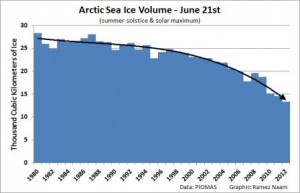
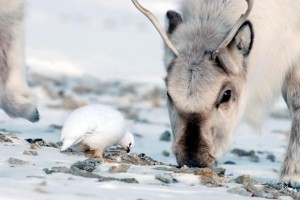
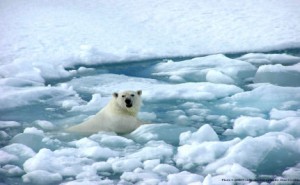
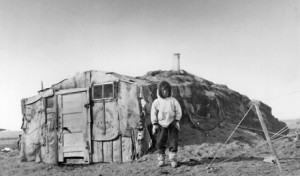
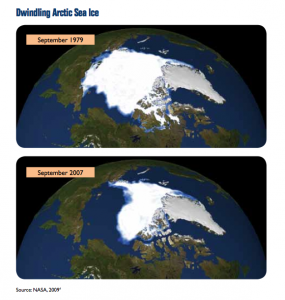
Rash Realism
Recently, there has been an increasing trend of further interest and action towards mitigating the present matters of global climate change (Held) leaving hope of cooperation in contrast to the realist view. The realist view acknowledges global challenges but believes that these state issues are direct causes of other states and that these issues should be solved through self-help and military power (Bova 238-239). Realist thinkers often perceive the notion of cooperation to resolve issues is foolish and naïve. (Bova 249-250) The question then becomes, have the past and present helped to indorse realistic thoughts or is there hope that global collaboration is possible in the future? To me, the answer to such questions is that realists should contemplate the “self-help” idea, asking themselves if that is really enough to combat adequate enough responses to present threats. (Bova 239)
In the past, yes maybe this view would make more sense in a time before conferences of the parties were a thing and where there were less regulations or targets for emissions reductions in place. Hell, even at a time when the notion of attempting emissions reductions through the Kyoto Protocol was on the rise, realism may be justified. There were large emitters of green house gases that would not sign the protocol and many developing countries with fewer emissions were not required to reduce. In situations like this, where all nations are not held accountable, it is reasonable that some may see the idea of “self-help” as the best or only option. Furthermore, in times of war or dispute between other nations, it is practical to not see global cooperation as a possibility.
But it is not the past, it is the present and with this we must look today to the inspiring and remarkable efforts that are rising from the developing nations, stepping up to be “climate leaders”. Numerous developing countries around the world are commencing and transforming from no involvement in the climate change problem to actually initiating their own actions; cap and trade systems, targets/goals, emissions reductions regulations, etc… This is happening in different parts of the world, regardless of whether they are huge top-ten emitters of greenhouses gases or not. (Held) These examples of more and more nations stepping up to the plate, looking to further address the problem is reason enough to me, for realists to recognize the escalating potential of collaboration.
We must look forward from the past and focus attention to the present and the future of such issues. Every man for himself has been a start to assessing the worldwide subject of climate change, but it is just that; worldwide and universal. To me, this means that everyone must assess together, that cooperation as the main focus, is the only way. We are all human beings alike, regardless. Realists know that there is a problem and they know that it needs to be addressed. It is “naïve” of them to not give hope to our world working together, not the other way around.
Works cited
**Arguments and ideas are supported by “Editors’ Introduction: Climate Governance in the Developing World.”
Held, David, Charles Roger, and Eva-Maria Nag, eds. “Editors’ Introduction: Climate Governance in the Developing World.” Climate Governance in the Developing World. Malden: Polity Press, 2013. 1-25. Print.
Russell Bova, How the World Works: A Brief Survey of International Relations (New York, NY: Longman Publishing, 2011)
The True Nature of a “Global” Problem
In much of popular rhetoric, global warming is called a “global problem.” Which, of course, is true. The Earth’s atmosphere and oceans obviously do not arrange themselves according to a country’s boundaries, and emissions from one country will affect the entire globe, not just the country of origin itself. Global warming is a problem that affects all corners of the world.
But what exactly does it mean for something to be a “global problem”? The way that the phrase “global problem” is interpreted can have radically different consequences for global climate change negotiations, as Harriet Bulkeley and Peter Newell discuss in their book Governing Climate Change.
Consider the global problem of GHGs (greenhouse gases), which have a major impact on climate change. Generally, it is assumed that the most important players in reducing GHG emissions are nation-states, as they are the most powerful actors in the anarchic international system. But, as Bulkeley and Newell argue, oftentimes these nation-states are limited as to how directly they are able to influence carbon emissions in their country. Most of the time, it is non-state actors, such as multinational corporations or individual consumers, that most directly influence the amount of carbon emissions.
Furthermore, even if international agreements on climate policy seem to assume that nation-states can easily reduce or contain these emissions, much of the time it is a lot more complicated as to how much influence governments really have. That is because most of the GHGs produced in a country are emitted by processes and actors that defy national borders.
It is very complicated as to how to deal with emissions by non-state actors across national borders, but one of the first things that should be done is to increase consumers’ environmental awareness and education. Most people–myself included– do not understand how much of an impact they can have on the environment, even if they are just buying food at a supermarket. Meat has a higher carbon footprint than most other foods, as it requires fossil fuels to produce fertilizer and provide irrigation for the corn feed, and ruminant animal’s waste generates methane, which is a large contributor to global warming. This is just one of the ways that what we buy affects the environment. It’s not the only solution, but more educated consumers could have a large impact on the mitigation of climate change, and might even help to change the attitudes of corporations and industries to become more environmentally friendly. This change at the community level is a very important step in changing the attitude of society toward climate change.
The Weather in 2050
On the UNFCCC newsroom homepage today I found the video at the bottom of this blog post. The first four minutes of the video show a news anchor man going through the current weather across the US with a hurricane off the coast of Florida, a heat wave in Chicago and a server drought in the south-west US. The video ends with Ban Ki-Moon addressing the viewers and asking for us to take action on climate change with him. On one hand the video seems overly dramatic. But, is this what it takes to get people to take up Ban Ki-Moon’s call for action?
After investigating the WMO’s website, I was able to find a link to a series of videos that the organization is running in preparation for the Climate Summit at the end of the month in New York City. A list of those videos can be found here.
It is very interesting to me that they are running this campaign on weather related events. We know that there is not a clear connection between any given daily weather event and climate, yet, this video series suggests that weather when examined in different locations globally is an indication of a warming climate. These videos are consistent with the predictions of climate modelers, according to the WMO website. So, maybe this is an effective way of convincing people of the real dangers of climate change. What do you think?

